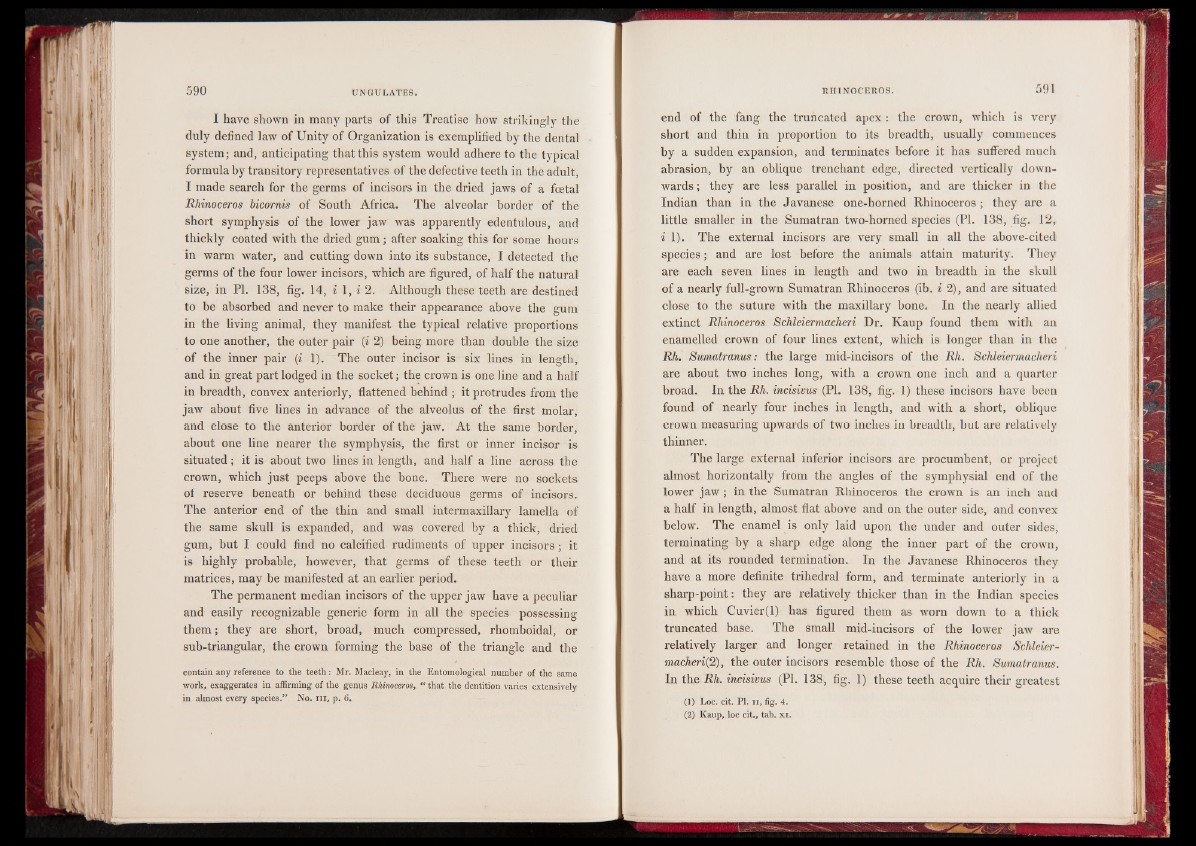
I have shown in many parts of this Treatise how strikingly the
duly defined law of Unity of Organization is exemplified by the dental
system; and, anticipating that this system would adhere to the typical
formula by transitory representatives of the defective teeth in the adult,
I made search for the germs of incisors in the dried jaws of a foetal
Rhinoceros bicornis of South Africa. The alveolar border of the
short symphysis of the lower jaw was apparently edentulous, and
thickly coated with the dried gum; after soaking this for some hours
in warm water, and cutting down into its substance, I detected the
germs of the four lower incisors, which are figured, of half the natural
size, in PI. 138, fig. 14, i 1, i 2. Although these teeth are destined
to be absorbed and never to make their appearance above the gum
in the living animal, they manifest the typical relative proportions
to one another, the outer pair (i 2) being more than double the size
of the inner pair (i 1). The outer incisor is six lines in length,
and in great part lodged in the socket; the crown is one line and a half
in breadth, convex anteriorly, flattened behind ; it protrudes from the
jaw about five lines in advance of the alveolus of the first molar,
and close to the anterior border of the jaw. At the same border,
about one line nearer the symphysis, the first or inner incisor is
situated; it is about two lines in length, and half a line across the
crown, which just peeps above the bone. There were no sockets
of reserve beneath or behind these deciduous germs of incisors.
The anterior end of the thin and small intermaxillary lamella of
the same skull is expanded, and was covered by a thick, dried
gum, but I could find no calcified rudiments of upper incisors; it
is highly probable, however, that germs of these teeth or their
matrices, may be manifested at an earlier period.
The permanent median incisors of the upper jaw have a peculiar
and easily recognizable generic form in all the species possessing
them; they are short, broad, much compressed, rhomboidal, or
sub-triangular, the crown forming the base of the triangle and the
contain any reference to the teeth: Mr. Macleay, in the Entomological number of the same
work, exaggerates in affirming of the genus Rhinoceros, “ that, the dentition varies extensively
in almost every species.” No. ni, p. 6.
end of the fang the truncated apex: the crown, which is very
short and thin in proportion to its breadth, usually commences
by a sudden expansion, and terminates before it has suffered much
abrasion, by an oblique trenchant edge, directed vertically downwards
; they are less parallel in position, and are thicker in the
Indian than in the Javanese one-horned Rhinoceros ; they are a
little smaller in the Sumatran two-horned species (PI. 138, fig. 12,
i 1). The external incisors are very small in all the above-cited
species; and are lost before the animals attain maturity. They
are each seven lines in length and two in breadth in the skull
of a nearly full-grown Sumatran Rhinoceros (ib. i 2), and are situated
close to the suture with the maxillary bone. In the nearly allied
extinct Rhinoceros Schleiermacheri Dr. Kaup found them with an
enamelled crown of four lines extent, which is longer than in the
Rh. Sumatranus: the large mid-incisors of the Rh. Schleiermacheri
are about two inches long, with a crown one inch and a quarter
broad. In the Rh. incisivus (PL 138, fig. 1) these incisors have been
found of nearly four inches in length, and with a short, oblique
crown measuring upwards of two inches in breadth, hut are relatively
thinner.
The large external inferior incisors are procumbent, or project
almost horizontally from the angles of the symphysial end of the
lower jaw ; in the Sumatran Rhinoceros the crown is an inch and
a half in length, almost flat above and on the outer side, and convex
below. The enamel is only laid upon the under and outer sides,
terminating by a sharp edge along the inner part of the crown,
and at its rounded termination. In the Javanese Rhinoceros they
have a more definite trihedral form, and terminate anteriorly in a
sharp-point: they are relatively thicker than in the Indian species
in which Cuvier(l) has figured them as worn down to a thick
truncated base. The small mid-incisors of the lower jaw are
relatively larger and longer retained in the Rhinoceros Schleier-
macheri(2), the outer incisors resemble those of the Rh. Sumatranus.
In the Rh. incisivus (PI. 138, fig. 1) these teeth acquire their greatest
(1) Loc. cit. PI. ii, fig. 4.
(2) Kaup, loc cit., tab. xi.